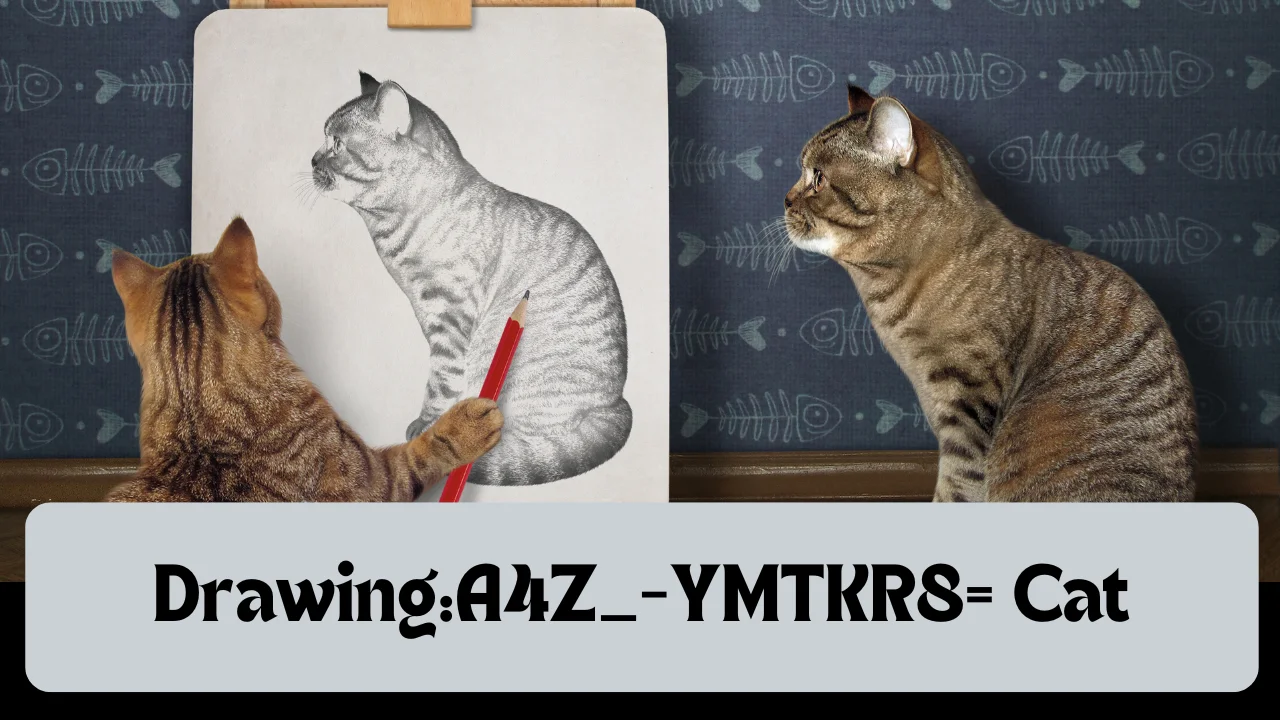Introduction
Art has long served as a vehicle for the expression of the complex beauty of the natural world, and cats in particular have long been a favorite subject for artists. Beautiful cat illustrations can be yours with the help of the intriguing “Drawing:A4Z_-YMTKR8= Cat” technique, which blends classical and contemporary art practices. This approach highlights the artist’s individuality and inventiveness while simultaneously paying close attention to the cat’s anatomy. Get ready to dive into the “drawing = cat” technique’s fundamentals as we uncover its core principles and show you how to draw adorable cats.
Understanding “Drawing:A4Z_-YMTKR8= Cat”
“Drawing:A4Z_-YMTKR8= Cat” is shorthand for an approach to drawing that combines realistic proportions with more imaginative techniques in order to convey the spirit of a feline. Not only does this style of cat drawing place an emphasis on accurately representing the anatomy of the feline, but it also adds distinctive stylistic touches that set the pieces apart.
For “drawing = cat” to work, one must first have a firm grasp on the proportions and anatomy of the feline. This involves becoming an expert on the unique gait, limb flexibility, spinal curvature, and facial characteristics of cats. Using this method, artists capture the essence of a cat through its minuscule features, such as its eyes, fur, and the way it poses to convey emotion.
Aside from the purely technical considerations, “drawing = cat” also pushes artists to bring their unique creativity to their work. Trying out a range of realistic and abstract styles, as well as various media (pencils, ink, digital tools, etc.), could be part of this process. The objective is to express one’s individual creative vision while simultaneously creating an item that faithfully depicts a cat.
The Basics of Cat Anatomy
Understanding Cat Proportions
Knowing the measurements of a cat’s body is the first step in becoming an expert at the “drawing = cat” method. The distinctive skeleton of cats grants them the remarkable abilities of grace and agility. They have a lot of mobility thanks to their long, comparatively body-length limbs and extremely flexible spines. To capture the grace and fluidity of a cat’s movements in a drawing, it is essential to capture these proportions correctly.
Observing Cat Movement
The graceful, nearly liquid-like movements of cats are well-known. You can learn a lot about the mechanics of a cat’s body just by watching it move around. Then, using this information, artists can create drawings that perfectly depict the elegant beauty of cats. Mastering the “drawing = cat” technique requires meticulous attention to detail, whether you’re depicting a cat leaping, stretching, or just walking.
Detailing Cat Features
The face of a cat is one of its most expressive features. All of the cat’s facial features, including its eyes, whiskers, and ears, work together to form its expression. Be very precise with these details if you want your cat drawing to turn out well. Pay close attention to the eyes because they serve as the drawing’s focal point. Another crucial part is accurately depicting the fur’s texture, which gives the piece more depth and realism.
Capturing the Essence of a Cat
Expressing Emotions through Poses
Cats’ body language conveys a multitude of emotions. Your drawings can capture a range of emotions with these cat poses, from a carefree sunbather’s stance to a vigilant predator’s poised stance. Learning and then imitating these positions will give your artwork more depth, making it more interesting and realistic.
Using Creative Techniques
Although meticulous attention to detail is essential, “drawing = cat” also suggests that artists try out new approaches to express their individuality. Some examples of this practice include playing around with different shading techniques to give the impression of depth, using color to convey feelings, or adding abstract elements to the drawing to make it more interesting. Achieving a unique artistic style requires striking a balance between realism and creativity.
Blending Realism and Creativity
Exploring Different Styles
The “drawing = cat” method is flexible enough to accommodate different kinds of art. There is space for imagination, regardless of whether you lean toward realism or abstraction. While some artists prefer to capture the feline form as closely as possible, others prefer to stylize their work by adding exaggerated features or bold colors. The great thing about this method is that it can be customized and experimented with indefinitely.
Incorporating Artistic Vision
Every artist has their own distinct point of view, and “drawing= cat” is a great platform to share those ideas. Your cat drawings can become works of art in their own right if you let your creative spirit shine through. Your creative vision can give the “drawing = cat” technique a fresh spin by way of innovative compositions, delicate shading, or strong lines.
Mastering “Drawing = Cat” Techniques
Tools and Materials
If you want to become an expert at the “drawing = cat” method, you must master the art of material selection. Pencils, charcoal, and digital drawing tablets and software are all viable options; which one you choose will depend on your chosen medium. You need to try out various tools to discover what works best for you, since each medium has its own advantages and disadvantages. Moreover, the end result of your drawing might be affected by your choice of canvas or paper.
Step-by-Step Tutorials
The “drawing = cat” method can be very useful for newcomers if they follow detailed tutorials. Typically, these guides will begin with the most fundamental of shapes and lines before moving on to more intricate topics. If you follow these guides, you should be able to draw cats with more accuracy after you learn the anatomy of the animal. Once you’ve mastered the technique, you can begin to add your personal flair and imagination to your projects.
Common Challenges and Solutions
Getting good at the “drawing = cat” method is difficult, but so is getting good at any art form. Obtaining the proportions correct is a typical challenge since an inaccuracy can derail the entire drawing. Another difficulty is depicting the fur’s texture, which calls for precise shading and attention to detail. These obstacles, however, can be surmounted with practice and persistence. Keep in mind that any slip-up can be a stepping stone to a better you.
FAQs
1. What is the “drawing = cat” technique?
The “drawing = cat” technique is an approach to drawing cats that combines anatomical accuracy with creative expression, allowing artists to capture both the realism and artistic vision of the subject.
2. How can I improve my cat drawing skills?
Practice regularly, study cat anatomy, observe live or video references of cats, and experiment with different styles and techniques to find what works best for you.
3. What tools are best for “drawing = cat”?
Pencils, charcoal, and digital drawing tablets are popular choices. The best tools depend on your preferred medium and style.
4. Can beginners learn the “drawing = cat” technique?
Yes, beginners can learn this technique by starting with basic tutorials and gradually building up their skills in anatomy, proportions, and creativity.
5. What makes a cat drawing stand out?
A cat drawing stands out when it captures the essence of the cat’s personality and features, combined with the artist’s unique style and creative approach.
Also Read: HSNime: Watch Your Favorite Anime Series Now
Conclusion
A lovely synthesis of classical and contemporary art practices, the “Drawing:A4Z_-YMTKR8= Cat” method enables artists to depict cats as they really are. Amazingly realistic drawings of cats are possible if one takes the time to study their anatomy, learn how they move, and focus on the finer points of their features. While doing so, the method pushes you to inject your work with your own creativity by trying out various approaches until you find one that works for you. No matter your level of artistic expertise, “drawing = cat” provides limitless possibilities for creative expression and discovery.

Jennifer Forster is a skilled writer at Explainervilla.com, where she covers a wide range of topics such as technology, lifestyle, and culture. Her work emphasizes how contemporary trends intersect with traditional values, breaking down complex innovations and sustainability initiatives into easy-to-understand insights.
